Archive for December, 2015
-
WALKING WITH THE DEAD
“As soon as they saw us approaching with our horses, some shop owners hurried to close their doors in order to show us that we were not welcome,” remembered 74 year old, Alfred Mifsud. “This happenned mostly in the villages of Ħal-Kirkop and Safi, and in other areas of northern Malta. It was more a reaction to the sense of disgust which people felt towards our job rather than because of any superstitious fear that we could attract death to their doorstep. In fact, those who did let us in their shops to drink a cup of tea, had a number of reserved cups for us, since other clients would refuse to use them.”
In the old days, it was hard to be an undertaker. Work started from the early hours, when it was still dark, as it took long to prepare the horses and the carriages, and then to drive to church. The deceased was placed in a coffin and was generally carried on the shoulder, from his house to the chapel or church where mass was celebrated in the early morning, so that those who attended, could go to work soon after. In the meantime, the undertakers would stay outside, waiting to carry the coffin to the cemetery.
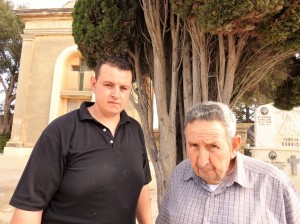 “By that time, after travelling the long road on a hard seat in the cold, we would be yearning for a cup of tea. Yet there were moments when where it not for the kindness of the church’s sacristan, we would be bound to wait for hours before we could drink something warm.”
“By that time, after travelling the long road on a hard seat in the cold, we would be yearning for a cup of tea. Yet there were moments when where it not for the kindness of the church’s sacristan, we would be bound to wait for hours before we could drink something warm.”Certainly, this was a minor discomfort when considering what the rest of the job entailed.
“People might think that undertakers will eventually get used to death and will become numb to the pain which it brings with it. However, they are definitely mistaken because we are often saddened by the suffering, especially when children are somehow involved. How can you remain indifferent when you see parents burying their child or when you hear the cry of the young ones when they see their mum or dad being hauled underground?”
A shudder ran through me and I wondered how anyone could withstand to do such a job.
“You learn to accept death as part of the circumstances of life and consider your job just like any other. You do your duty as best as you can in order to see that everything will run smoothly and that your client is served well.”
When Alfred was twelve years old, he was already assisting his dad, who was also an undertaker, to prepare the deceased for burial. He also gave a hand to other undertakers by helping them out in cemeteries. Even as a child, this work did not upset him and he was never afraid of dead people or burial grounds.
“Our family has been doing this work for more than a century now. It was Lukardu Pace, my father’s uncle, who started a career in this sector, by carrying the dead in funeral carriages. After he died in a traffic accident, my father Fidiel, who is now 93 years old, took over this job, and he introduced us in this work. Eventually it was only me who became a funeral carriage driver besides being an undertaker. However my brothers opened another business which is related to funerals.”
As Alfred began to show me some old photographs of the different funeral carriages that were available at the time, I realized that although death does not differentiate between the rich and the poor, nonetheless, affluent persons still insisted to distinguish themselves from others until the very end.
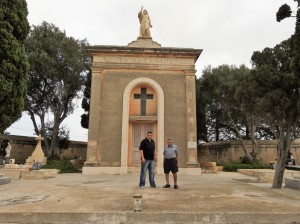 “Prosperous families used the carriage known as ‘tal-prima’ which was very elaborate and richly designed with golden sculpture. It was made of mahogany and it was drawn by four black horses that were adorned with feathers and an elegant pall. Then there was ‘tas-sekonda’ carriage which was made of cheaper painted wood and was accompanied by two black horses. A carriage painted in white and decorated with flowers was utilized to carry dead children and teenagers. In this case, the black horses were dressed with a white pall which was embellished with golden embroidery. ”
“Prosperous families used the carriage known as ‘tal-prima’ which was very elaborate and richly designed with golden sculpture. It was made of mahogany and it was drawn by four black horses that were adorned with feathers and an elegant pall. Then there was ‘tas-sekonda’ carriage which was made of cheaper painted wood and was accompanied by two black horses. A carriage painted in white and decorated with flowers was utilized to carry dead children and teenagers. In this case, the black horses were dressed with a white pall which was embellished with golden embroidery. ”Alas, there was no pomposity reserved for the destitute ones, especially if they had no family. The same thing applied to those who were in trouble with the Church.
“In the past, the Church had a much greater influence on the Maltese society. One was expected to receive the holy communion at least once a year, and a ticket known as ‘bulettin’ was given to those who adhered to this regulation. Those who did not, were not considered as part of the Church, and if they died, they became known as ‘ta’ bla preċett’. No priest would accompany them for their burial, and obviously, no mass would be celebrated. They would simply be carried away in a carriage and were buried in a particular section in the cemetery which was reserved for such people. I remember my father narrating how in such cases, the families of the deceased would insist with him to go and collect the dead relative during the night so that the neighbours will not see what was happenning. Then he would go and wait behind the cemetry’s door in order to be the first to enter once it opens, and hasten the burial before other people are around.”
Alfred remarked that the tradition to celebrate a funeral mass started from the 1970s. Before that period, the family would only organize a short function prior to the burial. In fact, during this time, he used to manage to attend to three or four burials in a day. This was not anymore possible, once funerals included also a longer mass.
“Along my 50-year career, I have witnessed many changes with regards to funerals. Amongst these, I remember many instances where the deceased was accompanied not only by family and friends, but also by members of a religious confraternity. There were also those who paid nuns and orphans from convents of charity in order to attend to their funerals.”
Interesting information kept pouring out as Alfred recalled his long experience in this work. Although happily married to Mary, he still reminisces the difficulty in his youth to find a partner, as many girls considered his work repulsive. Many years have passed from then on and the situation has somehow mitigated. However, Albert, his 29 year old son, who has followed his father’s career, told me that he had the same problem too.
 “I have been fascinated by my father’s work since I was five. Somehow, I was never afraid to help him out in cemeteries and I preferred to be with him than to go to school. Yet, I can understand the discomfort that other people who are not involved in this sector might feel in these circumstances.”
“I have been fascinated by my father’s work since I was five. Somehow, I was never afraid to help him out in cemeteries and I preferred to be with him than to go to school. Yet, I can understand the discomfort that other people who are not involved in this sector might feel in these circumstances.”“By now, I have learnt to take everything in stride, even when I notice some people making superstitious signs at me or at our hearses. There are moments when people make it embarassingly evident that they are uncomfortable with my presence. I remember clearly a particular instance when a person was so perturbed when he saw me waiting behind him in a queue, that he refused to take the rest of the money from the salesgirl and ran out of the shop.”
Just like his father, Albert admitted that when death is always on the order of the day, this job could engulf you with turmoil. Yet throughout these years, he was diligently coached by his father in order to learn how to protect himself from excessive grief, particularly by recognizing the significance of his work in alleviating this burden from the mourning family. Nevertheless, the fear of death is difficult to overcome, even when one faces it so many times.
“Instead of helping you to take death lightly, probably this work might make you perceive the end in a more dreadful way, since you know clearly what awaits you,” Albert said as he smiled nervously.
(This article was published in ‘Man Matters’ Supplement issued with The Times of Malta dated 19th December 2015)
-
A Christmas Nursery
Even as a young child, Paul Pace was very fond of baby Jesus statues. Probably because they reminded him of a number of significant familial moments. His grandma gave him a small wax statue of baby Jesus in order to ease down his sorrow after his father George had to leave for a long time to work with the Navy. On another occasion, his father surprised him when he bought him an expensive statue of baby Jesus that he had longed for, after he succeeded to win a lottery. Now, at 69, Paul owns a collection of more than 2000 of such statues which he has lovingly gathered in a museum that he called ‘Il-Mużew tal-Bambini’.
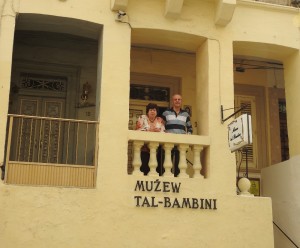 His wife Mary shares his passion and she is always present to give him a hand in this museum which they have purchased together.
His wife Mary shares his passion and she is always present to give him a hand in this museum which they have purchased together.“It is such a pleasure to see people getting emotional when they visit our museum. Some become very nostalgic as they remember their childhood. Others notice some statue which was similar to the one that their parents had, and they start recalling their memories. A number of visitors get inspired to buy a baby Jesus statue of their own, while some others decide to go home and search for their neglected antique statue which their grandma had left them,” Paul said.
Since its inauguration in 2010, il-Mużew tal-Bambini has become quite renowned both with the local and the foreign public. Although it is available for viewing by appointment throughout the year, most of the visitors attend to this museum during the Christmas season.
“There is always something new to see because we are continually adding to our collection. Even though by now, we have a problem with space, when we find a particular baby Jesus statue which we love, we just can’t help not to own it,” admitted Mary.
Certainly, the museum is a wonder to behold. The provenance of the statues is worldwide, thereby providing a rich overview of the different cultures. Skin colour, facial characteristics, and posture of these statues vary accordingly.
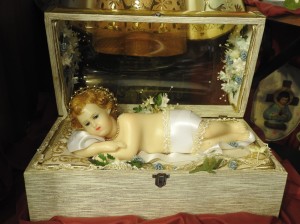 A delicate looking baby Jesus which was made in Malta, rests in a musical box and moves his eyes and hands. A dark skinned baby Jesus made from wood in Tanzania looks exotic amongst the others. A curly black-haired toddler Jesus, wearing the traditional costume of Perù, sits on a chair and weeps after stepping on a thorn, according to a local legend. A wooden statue from Betlehem shows Jesus as a boy dressed as a king and sitting on an elegant throne. A teenage Jesus from Atocia is also resting on a chair, but this time, he wears the clothes of a pilgrim and carries a rod. An intricately adorned statue of Jesus from Trapani is embellished with pomegranate for good luck.
A delicate looking baby Jesus which was made in Malta, rests in a musical box and moves his eyes and hands. A dark skinned baby Jesus made from wood in Tanzania looks exotic amongst the others. A curly black-haired toddler Jesus, wearing the traditional costume of Perù, sits on a chair and weeps after stepping on a thorn, according to a local legend. A wooden statue from Betlehem shows Jesus as a boy dressed as a king and sitting on an elegant throne. A teenage Jesus from Atocia is also resting on a chair, but this time, he wears the clothes of a pilgrim and carries a rod. An intricately adorned statue of Jesus from Trapani is embellished with pomegranate for good luck.“Our interest in this aspect has led us to travel to countries which are related to the life of Jesus, and from which we knew that we could find such statues. Our visit to the Holy Land was an incredible experience which gave us the opportunity to walk in the same roads where Jesus lived. Moreover, it was an ideal country from where to acquire some beautiful statues for our collection,” remarked Paul.
“When we visited Prague, we bought 42 different baby Jesus statues!” exclaimed Mary.
 They just had to, they explained, as they saw my startled reaction. This was because according to an old tradition, the statue of baby Jesus in Prague is dressed in different coloured clothes each day. Therefore, they were bound to purchase a number of statues which showed Jesus in several dresses. Nevertheless, not all the statues bought ended up in the museum, since some of these were presents for family members and friends.
They just had to, they explained, as they saw my startled reaction. This was because according to an old tradition, the statue of baby Jesus in Prague is dressed in different coloured clothes each day. Therefore, they were bound to purchase a number of statues which showed Jesus in several dresses. Nevertheless, not all the statues bought ended up in the museum, since some of these were presents for family members and friends.“Many of those who visit our museum are curious to know whether we can remember all our statues, which of course, we do. We can also recall all the places from where we have obtained these items. Each statue has an interesting story behind it and we love to share them with whoever’s interested to listen,” Paul said.
I was all ears and I felt simply fascinated when their narrative started to pour in. One of these stories entailed how they managed to buy a statue of baby Jesus which belonged to St. Ġorġ Preca. Another was related to an excellent bargain which Mary made unknowingly, when she bought a statue for her husband for a low price, and then found out that it dated to the 18th century. I loved also the account relating to a particular container made of mica which was produced in Malta by a German prisoner of war during World War II, and was utilized to hold a statue of baby Jesus.
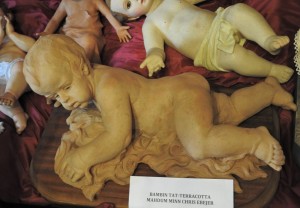 “We have many antique statues but the oldest one that we know the date of goes back to 1730. The smallest statue is about 15mm long, whereas the largest one has a length of 80cms. The materials of these statues varies widely and include: stone, alabaster, marble, woods of different kinds, wax, ceramic, concrete, lava, straw, plastic, wool, and even bull’s horn,” Mary explained.
“We have many antique statues but the oldest one that we know the date of goes back to 1730. The smallest statue is about 15mm long, whereas the largest one has a length of 80cms. The materials of these statues varies widely and include: stone, alabaster, marble, woods of different kinds, wax, ceramic, concrete, lava, straw, plastic, wool, and even bull’s horn,” Mary explained.Yet the strangest was yet to come…
“One day, we had a statue which lost its synthetic hair and we decided to try to replace it with some hair of one of our daughters. The experiment succeeded and soon, we provided the hair to a number of other statues by trimming some hair from our other daughter and eventually also from that of our nephews,” smiled Paul as he pointed them out proudly.
Each time that I observed the statues, I noticed a different one which I had not seen before. The collection looked literally endless, and yet each statue was unique. Whilst some of the statues showed simple features, mostly due to the artistic fashion of the time, others were quite elaborate and pretty. Yet there were also a number of outstanding characters which stood out from the rest.
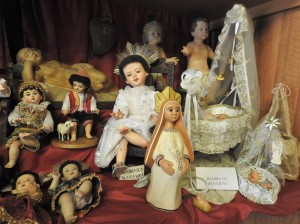 “The main aim of this museum is to share the sweetness of Christmas and the joy which is inherent in each statue of baby Jesus,” revealed the couple.
“The main aim of this museum is to share the sweetness of Christmas and the joy which is inherent in each statue of baby Jesus,” revealed the couple.However, this place offers much more than that since it nurtures love for one’s family, whilst it cherishes an appreciation for diversity. Undoubtedly, this collection is also an invaluable source for those who are interested to study the changes which took place along the years in the production of such precious artworks.
Il-Mużew tal-Bambini which is located at 17, Triq Santa Tereża, Birkirkara, will be open for the public from Sunday, 13th December 2015 to Wednesday, 6th January 2016.
Opening times: Monday to Saturday from 4:30pm – 8:00pm, Sundays and Public Holidays from 9:00am – noon and from 4:30pm – 8:00pm. For more information, one can call 21492111.
(This article was published in CHRISTMAS TIMES Suppliment issued with The Times of Malta dated 8th December 2015)
Travelogue
Archives
Recent Posts
- A MATTER OF FATE
- MALTA’S PREHISTORIC TREASURES
- THE MAGIC IS IN THE DETAIL
- THE SELLING GAME
- NEVER FORGOTTEN
- Ġrajjiet mhux mitmuma – 35 sena mit-Traġedja tal-Patrol Boat C23
- AN UNEXPECTED VISIT
- THE SISTERS OF THE CRIB
Comments
- Pauline Harkins on Novella – Li kieku stajt!
- admin on IL-KARNIVAL TRAĠIKU TAL-1823
- Albert on IL-KARNIVAL TRAĠIKU TAL-1823
- Martin Ratcliffe on Love in the time of war
- admin on 24 SENA ILU: IT-TRAĠEDJA TAL-PATROL BOAT C23